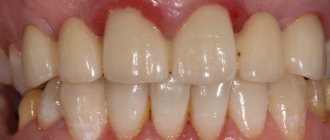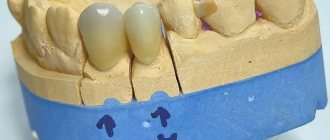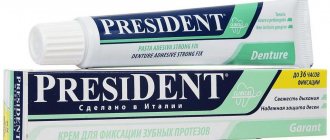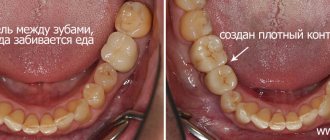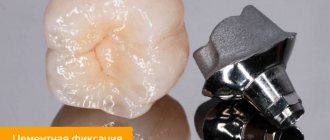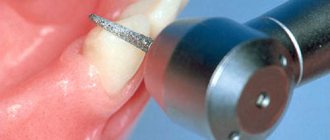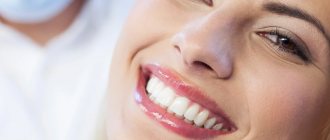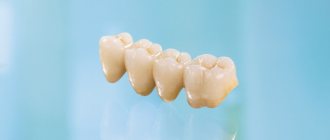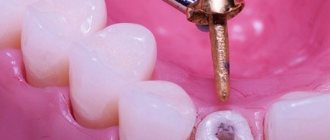Stages of bite deformation in children and adults
Doctors distinguish several stages of bite deformation.
The first is considered the easiest. It is diagnosed when the patient has a curvature of one or more teeth - they may have an irregular shape or length, an abnormal inclination and location, or may be rotated around their own axis.
The second or middle stage involves malocclusion throughout the entire row on one jaw or both.
To the third, most severe stage, experts include pathologies associated with the abnormal structure and size of the maxillofacial apparatus relative to the skull, violation of the position of the upper and lower jaws relative to each other, and the degree of closure of the teeth.
Important! Any, even the most minor, deformation of the bite, at a minimum, leads to a violation of the aesthetics of the smile and facial proportions, and at a maximum – to serious health problems. For example, to dental diseases and gastrointestinal pathologies, to respiratory failure, hypertonicity of the masticatory muscles and overload of the maxillofacial joint, to headaches, to early loss of teeth.
Indications for installing crowns for crooked teeth
If a patient is diagnosed with the first stage of bite deformation, when the defect involves 1-2 elements, then it is quite possible to solve the problem with the help of crowns. Their installation is indicated when the following anomalies are present:
- the tooth is rotated around its axis, tilted, has an irregular shape or a shortened/elongated crown part: you can align, or, more precisely, correct such teeth with crowns and make sure that they do not stand out from the rest,
- trema and diastema: designs will help fill excess space, reduce unaesthetic gaps,
- hard tissues are severely damaged as a result of caries, injury, or there is a chip: in this case, the product will help strengthen hard tissues, protect them from the effects of negative factors, from premature destruction or removal,
- slight crowding: for example, when the two front teeth overlap each other slightly.
The doctor may also recommend the installation of dentures before orthodontic treatment or at the final stage of bite correction using braces, aligners or trainers.
How to straighten teeth with braces
Braces are installed in stages. Preparation and diagnosis are especially important. The doctor conducts an examination, comprehensive diagnostics, and makes impressions of both jaws. At the first stage, contraindications to the procedure are determined. If there are no restrictions, then the dentist performs sanitation of the oral cavity. Professional cleaning and treatment of carious teeth is a prerequisite before fixing structures.
When installing sapphire or ceramic braces, you must first whiten your teeth. The corrective action is carried out due to external pressure. The main role is assigned to the rigid arc. Therefore, doctors regularly replace one arch with another. Depending on the complexity of the deformity, correction takes up to 1.5 years.
Types of bracket systems:
- metal - suitable for the most severe deformities; metal clasps provide more intense pressure, which reduces the duration of correction;
- ceramic - made of polymer based on aluminum oxide, due to this the systems are transparent and invisible;
- sapphire - made from a mineral that is grown under artificial conditions, such systems are hypoallergenic, durable, and resistant to coloring from food dyes.
Installing braces at the Propricus clinic will relieve you of pathologies of the dental system. Dental doctors begin treatment only after a comprehensive diagnosis. All changes and nuances are agreed with the patient. If any contraindications are found, the doctor will suggest you the most appropriate treatment.
When choosing sapphire models, keep in mind that this is the most expensive treatment. Metal systems are the most affordable correction method. To reduce costs, choose a turnkey braces installation service.
What are the contraindications
Correcting crooked teeth with crowns will not work if you have serious malocclusions that affect the entire jaw and affect its functionality. In this case, you cannot do without orthodontic appliances or even their combination with surgery.
Important! Why can’t prosthetics be done with crowns if, for example, there are anomalies not in 1-2, but in a whole number of teeth? The restorations will be unstable and short-lived, and their functionality will also be very mediocre. Thus, due to improperly distributed load, structures can chip, break, and even move apart, forming gaps between the teeth.
Installation is contraindicated for patients with inflammation of periodontal tissues, leading to loosening of the row. For example, with periodontitis and periodontal disease. Also, prosthetics should not be performed on people with bruxism or neuropsychiatric disorders.
Reviews from doctors and patients
Dentists consider dentures with crowns to be an excellent way to restore significantly damaged elements. Doctors note a significant advantage of this solution - it is an opportunity to prevent the destruction of a “dead” tooth or even preserve a “living” unit (if it is partially destroyed). This method cannot be called universal only because it has a number of contraindications, one of which is root damage.
Patients, for the most part, speak positively about prostheses of this type. They note the rapid restoration of functionality and aesthetics of the series, ease of use and durability of the prostheses.
Materials for the manufacture of structures
Materials can be very different:
- alloys of noble and base metals in pure form,
- metal ceramics,
- solid ceramics,
- zirconium dioxide,
- metal-plastic,
- plastic.
The desire of patients to install crowns in order to correct curvature, shape and position most often arises if the defect is present on the front teeth, which are noticeable to others. If you want to achieve maximum aesthetics specifically in the smile area, and for the result to please you for a long time, then it is better to choose designs made of ceramics and zirconium dioxide, because these materials most accurately imitate the structure, color and shine of enamel. Plus, their appearance does not change throughout their entire service life; they are not stained by food.
“My four front teeth on the upper jaw are healthy, without fillings or holes, but they were crooked. I really wanted a Hollywood smile without flaws and, naturally, as quickly as possible. I asked the doctor if it was possible to straighten them and give them aesthetics with crowns. I was ready to install the best and most expensive ones! But the dentist directly said that she would not take such a sin on her soul, and she would not deprive or file away living, albeit crooked, teeth. Why, he says, do you need this, so that they rot inside and slowly fall apart. Then you’ll take them off in 10 years, you’ll still be young, but you’ll need to remove them. Better, he says, go to the orthodontist. I then thought about it and followed her advice. I wore braces for a year and a half, then retainers for the same amount of time. And, in principle, I was satisfied with the result. The only thing I don’t like now is the color of the enamel, white spots have appeared, I want to bleach it.”
Flo, fragment of a review from the dental portal gidpozubam.ru
Features of care
The service life of metal-plastic crowns is limited by the service life of the plastic coating. If the prosthesis is severely damaged or deformed, it must be replaced. The average service time is 2-3 years. Plastic composite is a soft, cellular material that quickly adsorbs (absorbs) coloring pigments and changes color under the influence of chemical and thermal agents.
To extend the life of structures, you need to take care of them:
- Avoid seeds, nuts, and hard foods that can cause deformation of the prosthesis or chipping of the lining;
- do not consume products containing dyes (natural, artificial);
- Maintain hygiene - brush your teeth thoroughly, use soft brushes and toothpastes without abrasive particles;
- rinse your mouth after eating;
- undergo regular dental examinations and hygienic cleaning.
With careful care, a metal-plastic crown will last 3-5 years. This is confirmed by reviews from patients and doctors.
Article Expert
Alekperov Roman Borisovich Dentist-orthopedist, doctor of the highest category
Work experience: more than 32 years
Obvious advantages of crowns
The advantage is that you can straighten crooked teeth with crowns without long-term orthodontic treatment. At the same time, prosthetic structures promise an instant comprehensive effect: correction of shape, selection of a suitable color, strengthening of hard tissues and preventing their destruction, return of full chewing function.
Given their versatility, crowns seem more preferable to patients than braces. After all, after braces, for example, it is often necessary to carry out fluoridation and remineralization of the enamel, and to fight the stains that appear on it using bleaching. And here, immediately after installation, the smile aesthetics are excellent, and no additional measures to correct it are required.
Disadvantages that everyone needs to know about
Is it possible to correct crooked teeth with crowns? Structures cannot be treated. They only mask the defect, make it possible to achieve external attractiveness, but do not correct the cause of the pathology, i.e. broken bite. Therefore, their installation is advisable only if the anomaly is minor and does not threaten the health and functionality of the maxillofacial apparatus.
Another significant drawback: installing a crown is an irreversible process. Underneath it, you need to sharpen and depulp the tooth, and after removing the structure, it may even need to be removed. After all, a depulped unit is destroyed much faster than one in which there is living pulp. And in this regard, braces and any orthodontic devices benefit, because... after a course of treatment they can be removed; they do not require such sacrifices, although, of course, you have to wait a long time to get a positive result.
Important! Crowns do not allow you to change the incorrect location of the roots of the teeth and do not eliminate the cause of the anomaly. Therefore, it would be more correct to say that they do not straighten teeth, but only quickly restore their natural shape and color, and correct only individual defects.
Some patients believe that if they install a crown, they will not be at risk of caries or any other dental disease. However, this is a misconception. An inflammatory process can also develop under the structure if the canals were poorly treated, it was installed incorrectly, or due to insufficient hygienic care for the oral cavity.
Alternative Treatment Options
Some doctors believe that straightening crooked teeth with crowns is not the best idea. The method is quite radical, and it is better to use it only in extreme cases, for example, when a tooth, in addition to curvature, has other defects, for example, it is severely damaged by dental disease or injury, and the question arises of how to extend its service life. Or if the patient has a disease such as systemic enamel hypoplasia.
If the choice in favor of crowns is based only on the fact that you do not want to wear braces, then we recommend considering more preferable options for correcting minor bite defects.
Composite restoration
This is the fastest and least expensive option when you want to correct 1-2 teeth with slight deformations located in the smile area. For example, if one of them is slightly offset in relation to the others, then the doctor can use a composite to increase its thickness so that it becomes symmetrical relative to its “neighbors”. In this case, the enamel is not ground or drilled with a bur, but only slightly sanded for better adhesion to the filling material.
The advantages of the method are that, even if you later decide to correct your bite with braces or other orthodontic devices, a specialist will easily remove the composite without consequences for hard tissues.
Veneers and Lumineers
Thin overlays, no more than 0.7 mm thick, can perfectly mask three, several crooked or “short” teeth in the smile area. Moreover, to install them, the doctor will not grind hard tissues from all sides; he will only need to dissect the outer frontal area. To fix the lumineers, it will be possible to get by with only minor grinding of the enamel, which is necessary to ensure that the linings stay firmly in place.
Installation of veneers and lumineers, like crowns, does not require several years of treatment. Overlays allow you to get a quick, comprehensive result and hide all external defects, from slight curvature to unsightly enamel color. Plus, they also perform a protective function, protecting sensitive tissues from the temperature of food and bacteria.
Aligners
Unlike braces, they are soft, transparent and removable; they can always be removed from the mouth for eating and hygiene procedures. During use, they are more comfortable - this is important information for those who are thinking about how crowns correct teeth only because they find wearing braces very inconvenient.
Another advantage of aligners: they, unlike crowns, veneers and lumineers, do not mask the defect, but treat it.
Trainers
Suitable for correcting minor malocclusion pathologies, including affecting the main causes of its occurrence. Namely, they help to eradicate bad functional habits that contributed to the development of deformity. For example, trainers will help the tongue take the correct position in the mouth and help form the correct type of breathing and swallowing. The devices are often used for children, but are sometimes recommended for adults as well.
Why do teeth grow crooked?
Often children inherit not the best traits of their parents. If parents have a similar problem, the anomaly is likely to be passed on to the child. In addition to genetic predisposition, the deformity is provoked by a lack of vitamins and microelements in the diet of the expectant mother. The lack of solid food in the baby's menu, frequent mouth breathing, congenital anomalies - all this affects the formation of the dentition.
One of the common causes of malocclusion is thumb sucking in childhood. At school age, the child switches to sucking pens, pencils, and begins to bite his nails. Injuries and poor oral hygiene can also cause crooked teeth. Early loss of baby teeth can lead to crooked permanent teeth.
Problems with wisdom teeth
Initially, the dentition may be straight. If your dentist notices that it has started to become crooked, wisdom teeth may be the cause. Third molars displace adjacent teeth. But even after their removal, the dentition will no longer straighten on its own.
Often the eruption of eights occurs at the age of 20-25. If they have nowhere to erupt, they move their neighbors who are located in front. If before the appearance of figure eights the dentition was straight, then after their appearance orthodontic treatment may be necessary.
At a consultation appointment in our clinic, the doctor will assess the condition of the oral cavity. If necessary, he will remove third molars under anesthesia. You will not feel pain or discomfort. If you're self-conscious about your smile, it's time to make an appointment with an orthodontist.
Need some advice?
Enter your phone number and we will give you a free consultation
I want a consultation
*By making an appointment you consent to the processing of your data
Loss of teeth
When removed, teeth tend to fill the void and take up free space. By bending and moving, they create the basis for the improper development of others. This causes crowding.
In this case, the permanent tooth, which no longer has a place where it should erupt, follows the path of least resistance. He takes a place that is convenient for him. The cause of abnormalities in adults is injury. Under the chewing load, the dentition constantly shifts towards an empty space. Even if your bite was perfect before, in this situation it will deteriorate.
Underdeveloped dental system
The distant ancestors of mankind had no problems with the dental system. This is because they ate solid food that was not thermally processed. Due to the fact that people now eat freeze-dried food, the dental system does not develop as it should. As a result, the number of teeth remains the same, and the jaws do not fully develop.
This leads to crowding and the development of malocclusions. A person should eat solid food from childhood. Prolonged sucking of pacifiers negatively affects the formation of the dentition system.
